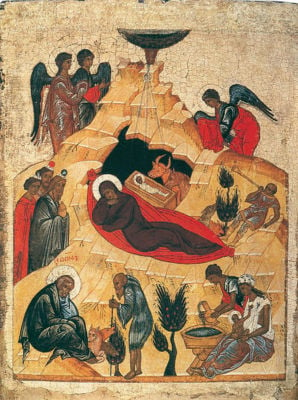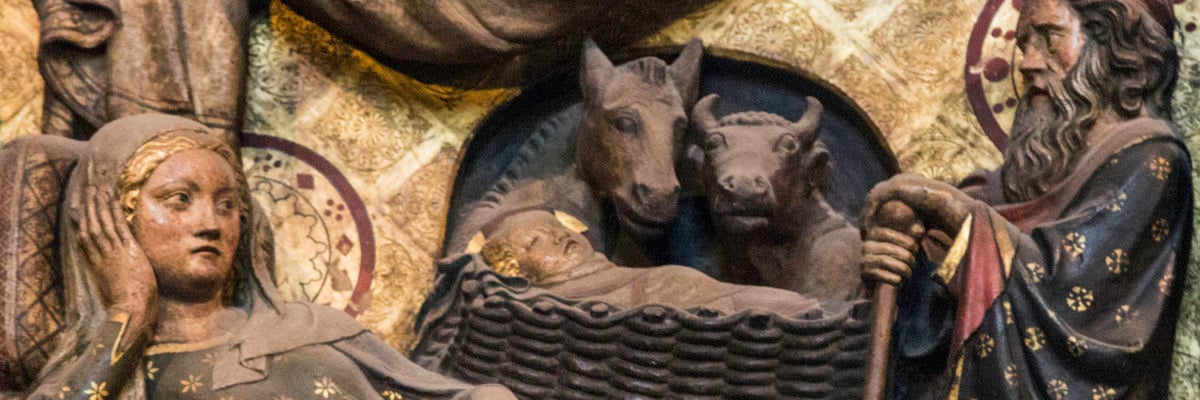
Every day, I stand in front of my home chapel’s iconostasis (icon screen) and look at icons of the twelve feasts celebrated in the Byzantine Catholic Church. One of these shows the Nativity of Our Lord—a rich and vibrant image, depicting many scenes surrounding Jesus’ birth. One of the most peculiar shows an ox and a donkey hovering over the infant Jesus, who is wrapped in a burial cloth and lying in a grave.

Credit: Jim Forest via Flickr, CC BY-NC-ND 2.0.
The foreshadowing of Christ’s death is understandable enough, but the seemingly random ox and donkey might raise an eyebrow. Yet are they really so random? In fact, there are plenty of other images of the Nativity that include the ox and the donkey. What is their significance?
In order to appreciate the answer, it is important to briefly consider that there are various ways in which Scripture may be read. In fact, we might say there are multiple layers to Scripture. The first is called the literal sense—the meaning “conveyed by the words of Scripture” (CCC 116)—followed by three deeper layers of Scripture, which as a group we could call the spiritual sense.
We can use the story of the crossing of the Red Sea in Exodus 14:19-31 as a demonstration. The literal sense of this story is that the people of Israel crossed a sea parted miraculously by God. But the crossing of the Red Sea may also depict, in a deeper, more spiritual way (CCC 117), the sinner’s journey into heaven through the waters of baptism.
What does this have to do with the ox and the donkey depicted in some Nativity scenes?
Consider Isaiah 1:3, which says, “The ox knows its owner, and the donkey its master’s crib; but Israel does not know, my people do not understand.” Now, some may say: I see the ox and the donkey, but I don’t see the connection to the Nativity Scene—isn’t this verse about Israel? In fact, it is: according to the literal sense, God chided the people of Israel for failing to obey his commands when even the animals do the will of God. According to the spiritual sense, we may say that the world did not recognize God when he took on human flesh, but the animals present at Christ’s birth did!
But why the ox and the donkey, and not other animals?
In the Old Testament, the ox was a considered a clean food for the Israelites. Some may see in this animal a depiction of the Israelites, who themselves were considered clean, being members of the covenant. The donkey, on the other hand, was considered an unclean food, which certainly may depict the gentiles, since they were not members of the covenant. For both to appear at Christ’s nativity is a powerful way to say that in Christ, Jews and gentiles are reconciled!
This is why Paul says to the gentiles, “But now in Christ Jesus you who once were far off have been brought near by the blood of Christ. For he is our peace; in his flesh he has made both into one and has broken down the dividing wall, that is, the hostility between us” (Eph. 2:13-14). And elsewhere he says, “There is no longer Jew or Greek; there is no longer slave or free; there is no longer male and female, for all of you are one in Christ Jesus” (Gal. 3:28).
In other words, in Christ, the major gap between those who are clean and unclean has been destroyed!
A deeper meaning to this imagery is the fact that the clean and unclean foods in the Old Testament can represent sin and holiness. These two symbols hovering over Christ wrapped in a burial cloth, lying in his tomb, show us that the struggle between sin and sanctity in our hearts will be overcome only by the incarnation and death of Our Lord.
And so the next time you see a fancy icon with bewildering imagery, do not be quick to dismiss it. If you search hard enough, you will find that it is rich in meaning!
Featured image: Detail from the medieval choir screen of Notre Dame de Paris. Credit: Lawrence OP via Flickr, CC BY-NC-ND 2.0.



